According to news stories from several sources tonight, the FBI is investigating a reported threat to bomb SpaceX’s Boca Chica Starship facility.
The source to the story comes from a local.
The report was made by Calvin Wehrle of Galveston, who frequently camps along Texas 4 near the Starship launch site.
In an interview Friday, he said he was there on the afternoon of Christmas Eve when an SUV pulled up with five male passengers who rolled down their windows to converse. They said they were from the Middle East. “I said something like, ‘What are y’all here for? ’ and the driver said, ‘Oh, we’re here to blow (Starship) up,’ ” Wehrle said. “I just went stone cold, and he said, ‘Oh, I got you. I was joking.’ ”
As the conversation went on, though, Wehrle’s visitors said at least three times they were in South Texas to attack Starship. He reported the incident to SpaceX and the sheriff’s office and said he was contacted later by an investigator.
This could be nothing, or it could be serious. The location of the Starship/Superheavy facilities is right along the road at Boca Chica, and it is very easy for anyone to get quite close. In fact there have been several incidences where people were caught trespassing.
Considering that SpaceX is gearing up for the seventh orbital test flight of Starship/Superheavy on January 10, 2025, the risks are now higher. The tank farm there, also not far from public access, is going to be filled with oxygen and methane, and will be an ideal target for attack.
And we can thank Joe Biden and his Democratic Party for allowing millions of illegals to enter the country un-vetted over the past four years, including tens of thousands who the evidence suggests could be potential terrorists. And we can also thank the Biden administration for sucking the quality out the FBI, making it incapable of doing its real job while it was used for political purposes harassing and persecuting Trump, many Republicans, and many ordinary conservatives.
Hat tip to BtB’s stringer Jay.

